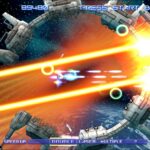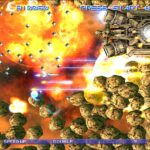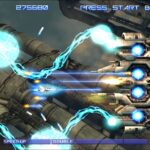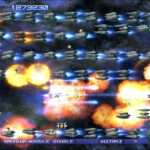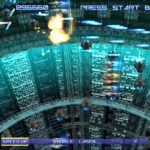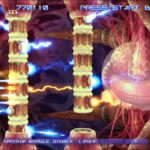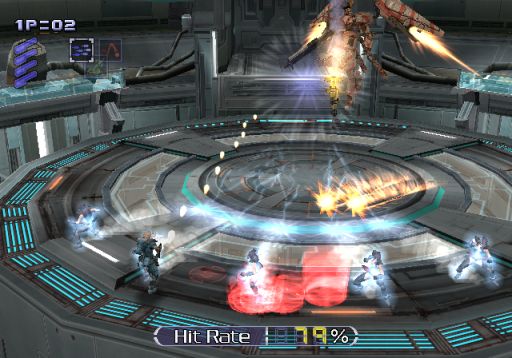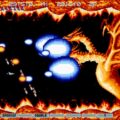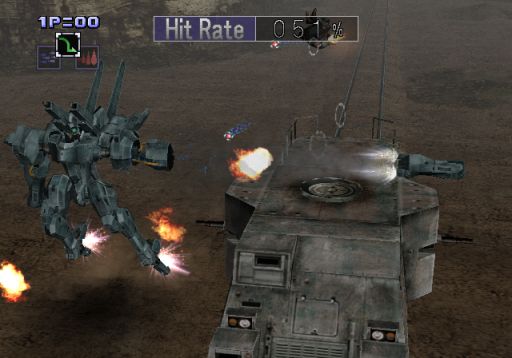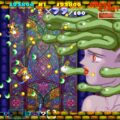Developer: Treasure Publisher: Konami Release: 09/14/04 Genre: Shooter
For a while in the mid-2000s it looked like Gradius was sent to the graveyard where once popular intellectual properties reside. Aside from the solid Gradius Galaxies there was nothing. Couple that with the near death of the shooter genre in America and it was reasonable to think we would never destroy a big core again. But Konami gave the series another chance with a little assistance from G.Rev and Treasure and blessed us with the fantastic Gradius V. The game is hard as nails but worth mastering for the sheer creativity and spectacle.
The story in Gradius V is simple yet incredibly satisfying. Long ago the Gradius army reduced the Bacterian army to nothing. But a few cells managed to survive and through the years have regrown into an army big enough to threaten the galaxy again. The Vic Viper is called in to action once again but is not strong enough on its own. I will just say the plot involves time travel and comes full circle in an unexpected yet satisfying manner.
Those who have grown accustomed to the weapon edit feature in the later games in the series will be disappointed. Gradius V initially allows you to select from four predetermined weapon load outs. These configurations are very limited, with the biggest changes between them being the type of missiles, double shot and the positioning of multiples (options). Unfortunately weapon edit does not become available until you complete the game once which is a tall task. The options available are expansive which makes the initial selection that much more disappointing. You will find seven types of missiles, four lasers like the ripple and even long forgotten weapons like the flamethrower.
Mechanically there are a number of changes that drastically change the gameplay. The Vic Viper’s hit box is significantly smaller; it is the cockpit of the ship! With this you can brush up against massive ships or squeeze through tight passages without dying. In fact the force field increases although you can survive three hits as a tradeoff. Multiples have an alternate control option using R1. Depending on the weapon array you can freeze them in place, change their firing angle, and widen their formation to cover more of the screen. It offers a high degree of control that is necessary in every stage. The second array (dubbed directional) with a laser equipped will allow you to control the laser like a hose or whip for instance. So even though you have less choice initially you still have options (heh).
One of the first things you will notice is the change in art direction. Previous titles featured a mix of worlds. You would usually visit a lava planet, a plant environ, and the requisite Moai stage. But outside of a biological level the art direction feels sterile. You spend more time in outer space among derelict space stations and mechanical war ships than planet side. Despite that it still looks fantastic overall. Like Ikaruga the game uses dramatic camera shifts to create a sense of spectacle not usually reserved for the genre. The bosses may seem familiar in their designs (and some are) but they slot in nicely among the returning roster. The lighting effects look spectacular and unlike Gradius IV the game never slows down. While the game could have used more variety in its setting it does an excellent job with what it has.
Despite less variety in its environments Gradius V succeeds through its creative scenarios. The Big Core is a Gradius staple that usually is not much of a threat. But here it chases you in a packed asteroid field before the inevitable battle. The fight itself is unique as those same asteroids are pulled toward you and you can use them as cover to block the core’s bullets. The Bacterion Multiplication plant shifts and scrolls in every direction making the deadly acid covering the level a permanent threat. My favorite is stage two. Here you storm a giant battleship alongside your future self as you both work together to destroy the brain of the ship. The camera work gives ample opportunity to use your multiple control and the normally useless double shot to great effect. The game’s creativity should not be a surprise; Treasure are masters at this sort of thing.
Even though it is not an arcade game Gradius V still has the same brutal difficulty. The reduced hitbox means the designers fill literally every inch of the screen with projectiles and enemies and it feels unfair at times. The game wastes no time showing you it means business as there is a boss rush in stage two! They usually reserve that for the end of the game! The bosses are bullet sponges that rob the encounters of their epicness as they drag on, especially if you die. They at least go away if you take too long but that is little comfort. For the first time you respawn after death and can also recollect your options if you are fast enough. Trust me it only helps a little bit. With rote memorization the game is manageable but I still feel it could have used a little more balancing.
In Closing
Gradius V is a difficult but outstanding entry in the long running series that is worth your time and lets the series go out on a high note. Even though it will kick your ass the spectacle and richness in its design will keep you coming back. Gradius Gaiden is still the best in the series in my opinion but this is a close second. They really need to make a follow-up, it has been long enough.


